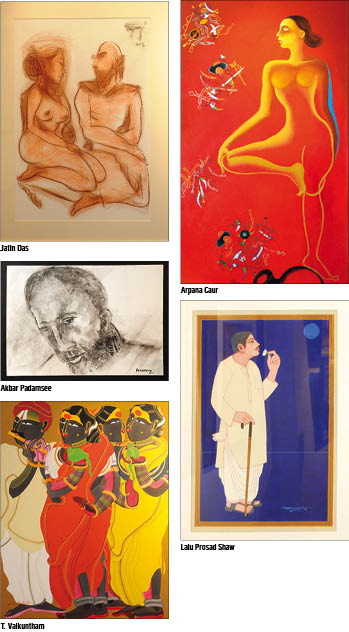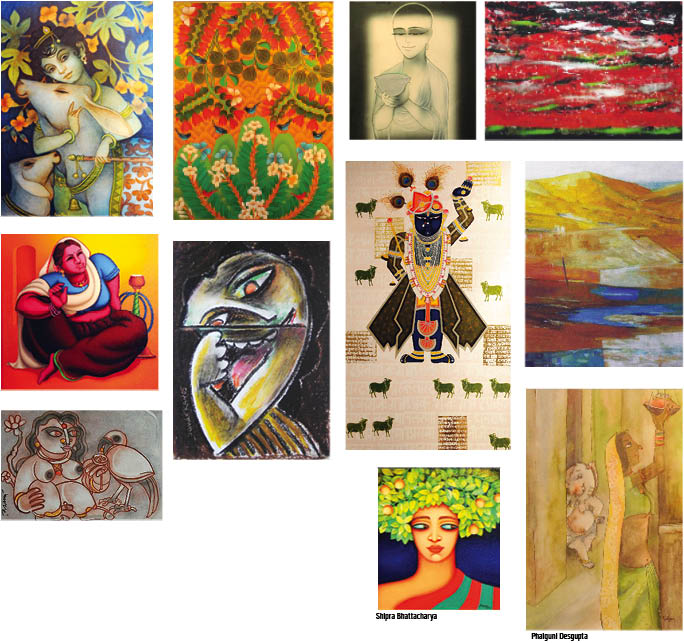The auspicious Diwali Season opens with a vibrant group Exhibition by twenty-two noted Indian artists having a "special sensibility". They have been carefully selected for this major group show entitled 'Indian Icons,' at the elegant Art Pilgrim Gallery at Sushant Lok, on display till 6 December. This rare collection of evolved artworks, by several well-known artists, includes fine pieces by Akbar Padamsee, Suhas Roy, Lalu Prosad Shaw, Vaikuntham, Sanat Kar, Ramanand Bandopadhyay, Jatin Das, Arpana Caur and Phalguni Dasgupta – as well as excellent representative works of younger promising artists such as Ramesh Gorjala, Bhagat Singh, Bratin Khan, Seema Kohli, Shiv Lal and Chhavi Rajpal, among others. Adding further depth and dimension to this iconic show, is a striking range of bronze and metal sculptures, by such masters as K.S Radhakrishnan and Dhananjay Singh.
A noteworthy aspect of this Exhibition is the elegance of its precincts. Gallery Art Pilgrim extends gracefully over two floors of a quiet private bungalow, tastefully managed by art-collector Geeta Singh, who has been an art-afficionado for over four decades. Aside from showcasing the recent works of significant painters, she has also included some major works from her own private collection in this special show -- including a series of imposing Christ canvasses and Portraits of Women by Suhas Roy, and several eyecatching contemporary sculptures. In art-exhibits, the importance of careful discernment in display and selection cannot be underestimated. Furthermore, sufficient space is a vital aspect to the proper viewing of art. Singh's low-profile and yet accomplished gallery scores highly in such essential details -- its subtly laid-out sense of space, refined ambience, state-of-the-art lighting, efficient management, and fine-tuned displays and layouts are of an international standard.
For an artist to be meaningful on a long-term basis, the artist's work must be relevant to the immediate times and milieu, as well as possess the power to transcend the literal towards the more 'timeless' realm of eternal ideas. High Art lies hidden within moments which may appear mundane; the accomplished artist has the miraculous ability to transform such 'ordinariness' into 'icons' of timeless stature and relevance. Thus, ordinary paints and base metals are transformed into forms of exalted beauty, that contain permanent social significance. In the curator, Suneet Chopra's words: "Art has the quality of taking a moment in time and giving it an eternal presence. Each moment catches the artists' eye and awakens their inherent artistic perception, to give it a new form. The works chosen in this Exhibition reflect this process in a unique way. Hence, we have dubbed this selection of artists 'Indian Icons', as we see them as instrumental in sharpening our sensibilities and awakening the best in us."

These 'iconic' artworks embody the Indian artists' great skill in the Figurative idiom, which they are able to transform masterfully into a contemporary aesthetic language. Indian art possesses a remarkable historic legacy of unique figuration – ranging from the intricate detailing of Indian miniature painting, to the looming iconic trajectories of the timeless cave-frescoes and sculptures of Khajuraho, Konarak, Ajanta and Sarnath. Our best contemporary art contains all the seeds of these traditions, flamboyantly expressed in a heightened contemporary mode.
In the Indian Icons collection one is enthralled by the painstaking Renaissance classicism of Suhas Roy's mysterious 60" x 30" Nude Tempera on Canvas in sepia tones. Similarly, the timeless classical lines of Lalu Prosad Shaw's Babu, in muted midnight blues in Tempera on paper, conveys the best of modern Indian Figurative art. Such evolved classicists are a rare breed, deserving the highest respect. Bengal has produced a wide range of such skilful draughtsmen, including Phalguni Dasgupta, whose depictions of Radha and Ganesha in this collection charmingly combine the classical with the Indian folk idiom.
Such exalted classical lines may be similarly admired in the mystical bronze sculptures of K S Radhakrishnan, and the metallic sculptures of Dhananjay Singh. Radhakrishnan, trained in Santiniketan as well as Baroda, exemplifies a high mastery of the timeless sculptural line in his finely-tuned minimalist figurative bronzes. With commendable maturity, he depicts a transcendent Christ, as if in a minimalist Sufi dance-mudra; while his smaller clusters of linear forms transfix the eye with their spontaneous tribal mode. Radhakrishnan's sculptures are equally inspired by Indian classicism and folk art, like the ancient Dhokra sculptors of Bastar in Madhya Pradesh.
Dhananjay stretches sculptural figuration further in his finely-strung metalworks of men and trees, composed of very finely-wrought slender metallic lines burnished in gold and silver patinas. His standing male torso in gold, radiating what seems like electrical wires, and his silver-toned tree with vein-like branches, bear an edgy, state-of the art finesse. Dhananjay's sculptures, by stepping out of conventional figuration, contain the mystery of Sci-Fi elements. Srinivas Reddy's haunting and mesmeric intricately-detailed red Fibreglass Head, and Ram Ramai's modernist metal sculpture of a woman with flowers in her hair, adds a further quirky touch to the sculptural section.

Rebelling against the formal parameters of painterly classicism, senior Indian artists such as Sanat Kar (inspired by Picasso), have created semi-abstract angular pastel heads in European-Cubist modes. And the vibrantly-exaggerated torsos of Vaikuntham have modernistically depicted traditional Tamilian rural womenwith bold, contemporary flamboyance. Arpana Caur's figurations are stylised and rigidly-simplified, in their attempt to denote an idea, rather than the literal. The Oils and Comtes of Akbar Padamsee and Jatin Das have always conveyed Modernist linear overtones over five decades of experimentation. More recent Indian artists have continued such strains, such as the elongated Buddhist figures of Datta Bansode, which bring to mind the modernist exaggerations of Modigliani.
There are also works in a semi-Abstract genre, by such artists as Jagjit Singh and Chhavi Rajpal. Jagjit Singh's repertoire -- evidently reminiscent of the master modernist Ram Kumar -- evokes the subtle geometry of mountainous landscapes with a tangential angularity. Rajpal's impressionistic acrylic strokes, evoking clouds and flora, convey a naivewhimsicality.
Among the younger artists, Bhagat Singh's idyllic, lyrical floralscapes, in luminous watercolours on paper, contain strains of the classical Mughal Garden, as well as the more modern flamboyance of William Morris' Art Decoratif. With a commendable full-spectrum palette of greens, blues, reds and oranges, he brings to life the Indian Miniature tradition in a modern format. Bratin Khan also chooses to dwell on India's pastoral and floral paradise, in his Tempera evocations of the child Krishna depicted in playful laasya-mudras with pet cows. Ramanand Bandopadhay, similarly, portrays modernistic Radhikas with pet parrots; while Dharmendra Rathore paints benevolent Buddhas in a neutral grey-black palette. Ramesh Gorjala brings alive his quintessential mythical Hanumans and Ganeshas in an enticingly Indian folk-narrative mode, while Charan Sharma paints Krishna as 'Sri Nath Ji' in the traditional Rajasthani Nathdwara style. By contrast, Shiv Lal depicts Christ's flagellation and abstract landscapes in graphic canvasses, while Seema Kohli paints pastoral linear gardens in simple, single-toned mixed-media drawings.
A wide range of Indian socio-cultural inspiration, and a great variety of the imaginative form, are thus to be found in this collection.
Read More...